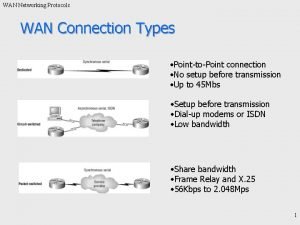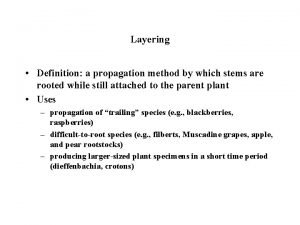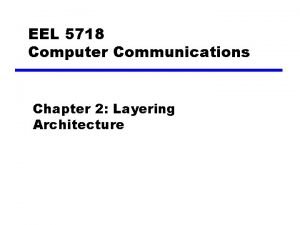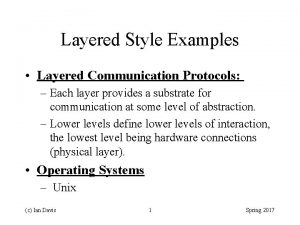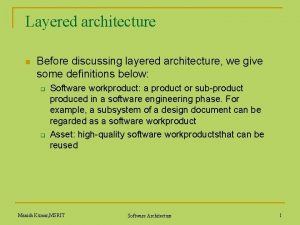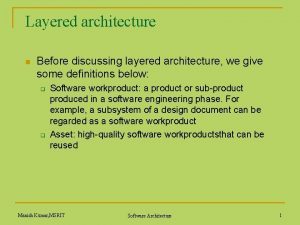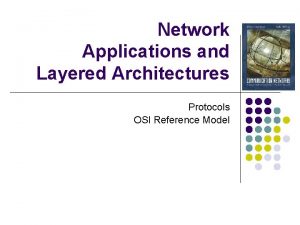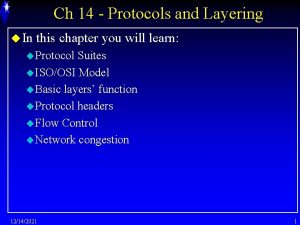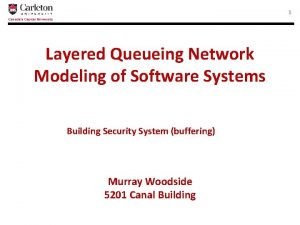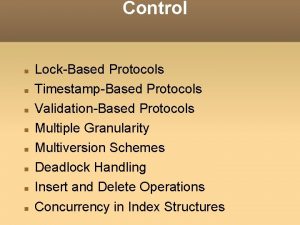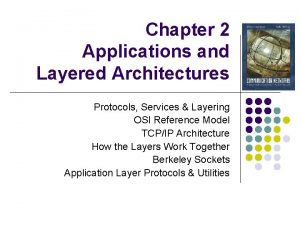Protocols and layering Network protocols and software Layered























- Slides: 23

Protocols and layering • • Network protocols and software Layered protocol suites The OSI 7 layer model Common network design issues and solutions

The need for protocols • Basic communication hardware can transfer bits from one place to another • Communication software provides a convenient high level interface for application programmers – do not have to deal directly with hardware – can run over different hardware • A set of rules for exchanging messages is a network protocol

Protocol suites • Rather than having a single giant protocol, protocols tend to be structured as suites of specific protocols – design and testing is easier – extension and updating is easier – selection and combination becomes possible

Layering • The most common approach to designing protocol suites • Each layer deals with a different level of abstraction and communicates with the layers above and below through a standard interface • There might be several alternatives for each layer

Example - the OSI 7 layer model • • ISO model for standardising all networks Now 20 years old and woefully out of date Probably too complex However, still provides useful terminology and a good general example of layering

The 7 OSI layers

Conceptual path of data

Commercially available stacks

Multiple nested headers • Each layer places information in a header before passing a packet to a lower layer and removes it before passing it to an upper layer

Layering principle • Layer N software on the destination computer must receive exactly the message sent by layer N software on the sending computer


Common networking issues • • • Sequencing for out-of-order delivery Sequencing to eliminate duplicate packets Re-transmitting lost packets Avoiding replay caused by excessive delay Flow control to prevent data overrun Mechanisms to avoid network congestion

Sequencing for out-of-order delivery • Connectionless network with dynamic routing may deliver packets out of order • Transport protocols solve this with sequencing • Each packet is given a sequence number • The receiver notes the number of the last packet that arrived in sequence and stores additional out of order packets • The packets are delivered in sequence to the next layer up

Sequencing to eliminate duplicates • Malfunctioning hardware can produce multiple copies of a packet • Sequence numbers allow duplicates to be detected and discarded

Re-transmitting lost packets • Packet loss is a fundamental problem due to transmission errors • One approach to reliable transmission involves positive acknowledgements – sender transmits and starts a timer – receiver receives and acknowledges – on time-out the sender transmits again – the receiver must watch out for duplicates – limit number of attempts before giving up

Avoiding replay caused by delay • A duplicate packet might turn up in a later session (e. g. , if it was queued in a switch for a long time) • May be confused with a packet from the later session that uses the same sequence number • Solution is to include a session identifier in the packet

Flow control to prevent overrun • Data overrun occurs when the sender sends faster than the receiver can receive • Simple solution is to acknowledge each packet before sending the next (“stop and go”) • However, this can be wasteful of bandwidth – capacity = 2 Mbps, packet size = 1000 octets, delay = 50 ms – sender has to wait 100 ms before sending next packet – data rate is 1000 octets every 100 ms = 80000 bps = 4% of available capacity

Sliding window protocols • Sender and receiver agree a window size (number of packets) • Initially a whole window is sent • After that, each packet is acknowledged and then another can be sent


Tw = T g x W

Congestion • Congestion arises due to too much traffic and/or bottlenecks in the network • Limited storage in switches means that packets get dropped

Dealing with congestion • Detecting congestion – switches can inform senders – packet loss can be used as a measure of congestion • Solution is rate control

The art of protocol design • The devil is in the detail – small changes in design can have drastic effects – mechanisms can interact in complex and unexpected ways
 Reasons for using layered protocols
Reasons for using layered protocols Layered tasks in computer network
Layered tasks in computer network Layered technology in software engineering
Layered technology in software engineering Software engineering layered technology
Software engineering layered technology Whats my ip
Whats my ip Chapter 3 network protocols and communications
Chapter 3 network protocols and communications Types of wan
Types of wan Network security protocols
Network security protocols Network security protocols
Network security protocols Wireless sensor network protocols
Wireless sensor network protocols Network communication protocols map
Network communication protocols map Objectives of plant propagation
Objectives of plant propagation Protocol agreement
Protocol agreement Tip layering plants examples
Tip layering plants examples Layering asexual reproduction
Layering asexual reproduction Pace layer model
Pace layer model What is placement in money laundering
What is placement in money laundering Trench layering
Trench layering Trench layering
Trench layering Definition of simple layering
Definition of simple layering This refers to the layering of different digital media.
This refers to the layering of different digital media. Risitic layering
Risitic layering Strict layering
Strict layering Layering food
Layering food






